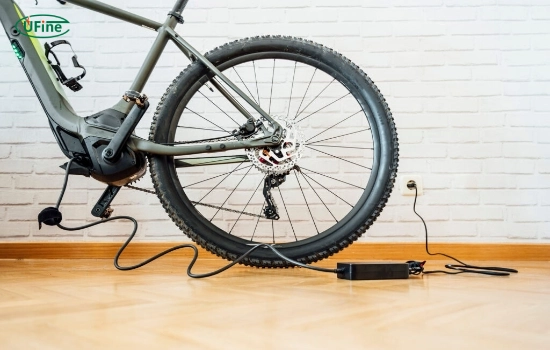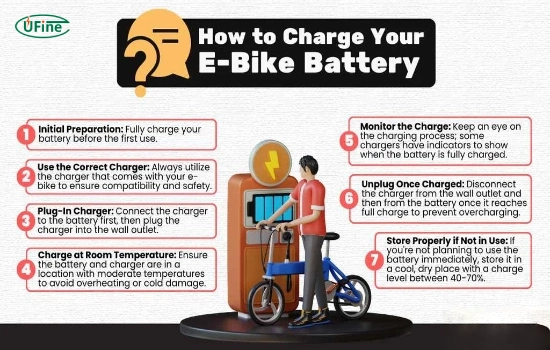As electric bicycles (e-bikes) gain popularity, understanding how to care for their batteries becomes increasingly essential. Many riders often wonder about the best practices for charging their ebike batteries, mainly whether they should charge them thoroughly every time. With the proper knowledge, you can significantly extend the lifespan of your ebike battery and ensure optimal performance. This article delves into the intricacies of e-bike battery charging, the impact of charging habits on battery health, and practical tips for maintaining your battery effectively.
Part 1. Understanding ebike batteries
Ebike batteries primarily use lithium-ion technology, which is favored for its high energy density and efficiency. Unlike traditional lead-acid batteries, lithium-ion batteries are lighter, have a longer lifespan, and can handle more charge cycles. However, they require specific care to maximize their longevity.
The chemistry of lithium-ion batteries allows them to be charged quickly and efficiently. Still, improper charging practices can lead to reduced capacity and shorter lifespans. Understanding how these batteries work is crucial for any ebike owner.
Part 2. Do lithium batteries need to be fully charged?
One of the most common myths surrounding lithium-ion batteries is that they must be fully charged to maintain health. In reality, fully charging these batteries is not only unnecessary but can also be harmful.
Studies indicate that lithium-ion batteries perform best when kept within a charge range of 20% to 80%. Charging to 100% can increase stress on the battery and lead to faster degradation over time. Therefore, it’s advisable to avoid total charges whenever possible.
Part 3. How often should you charge your ebike battery?
The frequency of charging your ebike battery depends largely on your riding habits. Here are some guidelines:
- Frequent Riders: If you use your ebike daily or for long rides, consider charging it after each use. This practice helps maintain the battery’s charge within the optimal range.
- Occasional Riders: If your rides are short and you don’t deplete the battery significantly, charging every few rides may be sufficient.
- Avoid Deep Discharges: It is essential to prevent the battery from dropping below 20%. Regularly allowing the battery to reach critically low levels can lead to irreversible damage.
Part 4. The impact of temperature on battery health
Temperature is a critical factor that affects battery performance and longevity.
- Cold Weather: Charging or using your ebike battery in freezing conditions can significantly reduce efficiency. Lithium-ion batteries can become sluggish in low temperatures, reducing range and power.
- Hot Weather: High temperatures can cause overheating, damaging the battery cells. Ideally, ebike batteries should be charged in a temperature range of 60°F to 70°F (15°C to 21°C) to ensure optimal performance.
Part 5. Best practices for charging your ebike battery
To prolong the life of your ebike battery, follow these best practices:
- Avoid Deep Discharges: Aim to recharge your battery before it drops below 20%. This practice helps reduce wear and tear.
- Charge in a Moderate Environment: Always charge your battery in a controlled temperature environment to avoid the risks associated with extreme temperatures.
- Limit Full Charges: While charging to 100% for maximum range may be tempting, frequent total charges can stress the battery. Instead, focus on partial charges whenever possible.
- Use the Correct Charger: Always use the charger that came with your ebike, as using an incompatible charger can lead to overcharging or undercharging.
Part 6. Common myths about ebike battery charging
Several myths persist regarding ebike battery charging habits. Here are a few common misconceptions:
Myth 1: You need to charge your battery fully every time.
Truth: It’s better to avoid total charges regularly. Partial charges, where you charge your battery to around 80% or 90%, can help prolong its lifespan. Constantly charging to 100% can strain the battery over time.
Myth 2: Leaving your battery plugged in indefinitely is safe.
Truth: Overcharging can damage your battery, even if most modern ebike batteries have built-in protections. It’s best to unplug the charger once the battery is fully charged to avoid unnecessary stress on the battery cells.
Myth 3: Cold weather doesn’t affect battery performance.
Truth: Cold temperatures can significantly reduce battery efficiency and performance. When it’s cold, your e-bike battery might not hold a charge as well or may discharge more quickly. It’s essential to store your battery in a moderate-temperature environment when not in use.
Part 7. The importance of battery maintenance
Maintaining your ebike battery is just as crucial as charging it correctly. Regular maintenance involves:
- Cleaning the Battery: Keep the battery terminals clean and free from dirt and corrosion, which can hinder performance.
- Proper Storage: If you plan to store your ebike for an extended period, ensure the battery is charged to about 50% and kept in a cool, dry place. This practice helps prevent capacity loss.
- Monitoring Battery Health: Regularly check the battery’s performance. Consult a professional if you notice a significant drop in range or efficiency.
Part 8. Signs your ebike battery needs replacement
Recognizing when your ebike battery is nearing the end of its life can save you from unexpected inconveniences. Common signs include:
- Shorter Range: If your battery doesn’t last as long as it used to, it may be time for a replacement.
- Swelling or Damage: Physical damage or swelling indicates that the battery is compromised and should be replaced immediately.
- Charging Issues: These are signs of degradation if the battery takes longer or doesn’t hold a charge.
Part 9. FAQs
-
Should I charge my e-bike daily?
Yes, mainly if you use it frequently. Daily charging helps maintain a ready-to-go battery. -
Can I charge my battery overnight?
It is generally safe, but avoid excessively leaving it plugged in for extended periods. -
How do temperatures affect my ebike battery?
Extreme temperatures can reduce battery efficiency. Keeping it at room temperature is ideal. -
What is a battery management system?
A battery management system (BMS) ensures safe charging and discharging of the battery, protecting it from damage. -
Can letting my battery die hurt it?
Letting it drop to a deficient charge can significantly decrease its lifespan. By following these guidelines and understanding how to care for your ebike battery, you can enjoy a longer-lasting and more efficient riding experience.
Related Tags:
More Articles

How High-Quality Lithium Battery Cells Are Made: A Comprehensive Guide
High-quality lithium battery cells stand out for their performance, reliability, and safety. Learn what sets them apart in materials, manufacturing, and testing
Comparing Mechanical Batteries and Lithium Batteries: Which Is Right for Your Application?
Explore the differences, advantages, and limitations of mechanical and lithium-ion batteries to find the best solution for your needs.
Exploring EV Battery Safety
Is your EV battery safe? Explore how EV battery safety works. Understand the role of battery cells and safety layers to protect your vehicle. Read more now!
What Type of Battery is Blade Battery? Unveiling Its True Features
Discover the key features of BYD's Blade Battery. Learn how it stands out in the market. Click to uncover its unique benefits now.
How Much Copper Goes into a Lithium-Ion Battery?
Copper is essential in lithium-ion batteries, powering devices from smartphones to EVs. How much copper is used? Let's explore the details.





